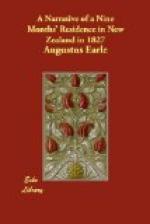Mooetara, the son and successor of the deceased, came to meet us on the beach, and seemed much gratified by our attention, our appearance on this solemn occasion giving him importance in the eyes of all the natives then assembled. He gave orders for our being conducted with much ceremony to the place of mourning, where, amidst a number of uncouth pieces of carving (which, we were informed were all tombs reared in honour of the memory of several former chiefs, and all tabooed), was erected a small hut, covered in at the top with thatch, but open at the sides. In the centre of this hut the bones of the deceased chief were exposed to view. After having undergone the process of decomposition during four months’ exposure to heat, wind, and rain, they had been collected, cleaned, and decorated with a quantity of fresh white feathers, which rendered the appearance of the skull still more frightful.
The women here invariably perform the parts of chief mourners; a group of them, with the widow of the deceased at their head, kept up a most mournful cadence, and at every pause in their dismal song slashed their skins with a piece of shell, till their faces, necks, and arms were literally streaming down with blood. This mourning and cutting is completely a matter of business, and is sometimes carried on without their feeling any real sorrow or sympathy. Parties kept arriving, and when there was not room for them to thrust themselves round the hut, they sat down in groups, perfectly unconcerned, employing themselves in cleaning their firelocks, or playing off upon each other some practical joke; but the moment a vacant space was presented near the hut, they deliberately stripped themselves, put on a most sorrowful countenance, and, seating themselves as near to the ornamented bones as possible, they immediately began their howling and slashing; no one seemed to like the idea of being outdone by his neighbour; but when the time allotted to this ceremony had expired, all instantly jumped up, wiped themselves, put on their mats, and joined the busy throng. There was, indeed, one real mourner, who never moved from the bones, nor once lifted up her eyes from them; she neither howled nor cut herself, and yet she inspired me with pity and commiseration for her forlorn state. This woman had been the only wife of the late chief; and I was informed they had lived many years together, and had a large family; she looked as if she herself was on the very brink of the grave. The contemplation of the mouldering remains of her partner through life must have been, even to her savage mind, most lacerating.




